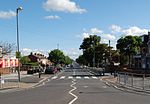Portal:Yorkshire
The Yorkshire Portal
Yorkshire (/ˈjɔːrkʃər, -ʃɪər/ YORK-shər, -sheer) is an area of Northern England which was historically a county. Despite no longer being used for administration, Yorkshire retains a strong regional identity. The county was named after its original county town, the city of York.
The south-west of Yorkshire is densely populated, and includes the cities of Leeds, Sheffield, Bradford, and Wakefield. The north and east of the county are more sparsely populated, however the north east includes the southern part of the Teesside conurbation, and the port city of Kingston upon Hull is located in the south-east. York is located near the centre of the county. Yorkshire has a coastline to the North Sea to the east. The North York Moors occupy the north east of the county, and the centre contains the Vale of Mowbray in the north and the Vale of York in the south. The west contains part of the Pennines, which form the Yorkshire Dales in the north-west. (Full article...)
Selected article

Middleton is a largely residential suburb of Leeds in West Yorkshire, England and historically a village in the West Riding of Yorkshire. It is situated on a hill 4 miles (6 km) south of Leeds city centre and 165 miles (266 km) north north-west of London. In 2001 the population of the Middleton Park ward of Leeds City Council was 27,487.
Middleton was occupied before the Norman Conquest and recorded in the Domesday Book of 1086. It developed as a manorial estate and its owners began to exploit the coal seams which outcropped within its boundaries. At the start of the Industrial Revolution a wooden wagonway was built to link the coal pits to Leeds. The colliery agent, John Blenkinsop designed an iron railway and its first steam-powered locomotive which was built by Matthew Murray in Holbeck. The coal mines on which the local economy was based lasted until 1967 and the railway is a preserved and run by a trust after operating for 200 years.
Middleton Park, a remnant of the manorial estate, contains a large area of ancient woodland and parts of it, where coal was mined, are designated a scheduled ancient monument. It was the location of Middleton Hall and Middleton Lodge homes to the local gentry.
The village developed along Town Street, a school, chapel and church were built in the 19th century but after the land was acquired by Leeds Council in 1920 a large council housing estate was built on the flatter land to the south, completely changing the rural nature of the settlement. (read more . . . )
Selected image

Credit: Kyle McInnes
Skidby Windmill is a Grade II listed working windmill at Skidby near Beverley, in the East Riding of Yorkshire. Originally built in 1821, the mill was further extended to its current 5 stories in 1870. (read more . . . )
Selected biography
Gerard (died 21 May 1108) was Archbishop of York between 1100 and 1108 and Lord Chancellor of England from 1085 until 1092. A Norman, he was a member of the cathedral clergy at Rouen before becoming a royal clerk under King William I of England and subsequently his son King William II Rufus. Gerard was appointed Lord Chancellor by William I, and he continued in that office under Rufus, who rewarded him with the Bishopric of Hereford in 1096. Gerard may have been with the king's hunting party when William II was killed, as he is known to have witnessed the first charter issued by the new king, Henry I of England, within days of William's death.
Soon after Henry's coronation Gerard was appointed to the recently vacant see of York, and became embroiled in the long-running dispute between York and the see of Canterbury concerning which archbishopric had primacy over England. Gerard managed to secure papal recognition of York's claim to jurisdiction over the church in Scotland, but he was forced to agree to a compromise with his counterpart at Canterbury, Anselm, over Canterbury's claims to authority over York, although it was not binding on his successors. In the Investiture Controversy between the king and the papacy over the right to appoint bishops, Gerard worked on reconciling the claims of the two parties; the controversy was finally resolved in 1107.
Gerard was a patron of learning, to the extent that he urged at least one of his clergy to study Hebrew, a language not commonly studied at that time. He himself was a student of astrology, which led to suggestions that he was a magician and a sorcerer. Partly because of such rumours, and his unpopular attempts to reform his cathedral clergy, Gerard was denied a burial inside York Minster after his sudden death in 1108. His successor as archbishop subsequently had Gerard's remains moved into the cathedral church from their initial resting place beside the cathedral porch. (read more . . . )
Selected list -

Selected Did You Know . . .

- ...that John Harrison (pictured), seventeenth century benefactor of Leeds, is reputed to have slipped Charles I a tankard of gold coins disguised as beer?
- ... that Humphrey de Bohun, Earl of Hereford was allegedly killed by a spear through the anus at the Battle of Boroughbridge in 1322?
- ...that Ebenezer Rhodes, Sheffield's Master Cutler, was declared bankrupt after losing money publishing books about Derbyshire?
- ...that the 364-metre pier in Withernsea, England was struck by ships four times, finally leaving it only 15 metres long?
General images -
Subcategories
Selected panorama

Topics
Related portals
WikiProjects
Things you can do
Associated Wikimedia
The following Wikimedia Foundation sister projects provide more on this subject:
-
Commons
Free media repository -
Wikibooks
Free textbooks and manuals -
Wikidata
Free knowledge base -
Wikinews
Free-content news -
Wikiquote
Collection of quotations -
Wikisource
Free-content library -
Wikiversity
Free learning tools -
Wikivoyage
Free travel guide -
Wiktionary
Dictionary and thesaurus



















































